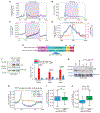RNA interacts with topoisomerase I to adjust DNA topology
- PMID: 39173639
- PMCID: PMC11380577
- DOI: 10.1016/j.molcel.2024.07.032
RNA interacts with topoisomerase I to adjust DNA topology
Abstract
Topoisomerase I (TOP1) is an essential enzyme that relaxes DNA to prevent and dissipate torsional stress during transcription. However, the mechanisms underlying the regulation of TOP1 activity remain elusive. Using enhanced cross-linking and immunoprecipitation (eCLIP) and ultraviolet-cross-linked RNA immunoprecipitation followed by total RNA sequencing (UV-RIP-seq) in human colon cancer cells along with RNA electrophoretic mobility shift assays (EMSAs), biolayer interferometry (BLI), and in vitro RNA-binding assays, we identify TOP1 as an RNA-binding protein (RBP). We show that TOP1 directly binds RNA in vitro and in cells and that most RNAs bound by TOP1 are mRNAs. Using a TOP1 RNA-binding mutant and topoisomerase cleavage complex sequencing (TOP1cc-seq) to map TOP1 catalytic activity, we reveal that RNA opposes TOP1 activity as RNA polymerase II (RNAPII) commences transcription of active genes. We further demonstrate the inhibitory role of RNA in regulating TOP1 activity by employing DNA supercoiling assays and magnetic tweezers. These findings provide insight into the coordinated actions of RNA and TOP1 in regulating DNA topological stress intrinsic to RNAPII-dependent transcription.
Keywords: DNA supercoiling; RNA-binding protein; TOP1; TOP1 interactome; magnetic tweezers; topology; transcription.
Published by Elsevier Inc.
Conflict of interest statement
Declaration of interests E.L.V.N. is co-founder, member of the Board of Directors, on the SAB, equity holder, and paid consultant for Eclipse BioInnovations. E.L.V.N.’s interests have been reviewed and approved by the Baylor College of Medicine in accordance with its conflict-of-interest policies. C.H. is a scientific founder, a member of the scientific advisory board and equity holder of Aferna Bio, Inc. and Ellis Bio Inc., a scientific co-founder and equity holder of Accent Therapeutics, Inc., and a member of the scientific advisory board of Rona Therapeutics and Element Biosciences.
Figures







References
-
- Pedersen JM, Fredsoe J, Roedgaard M, Andreasen L, Mundbjerg K, Kruhoffer M, Brinch M, Schierup MH, Bjergbaek L, and Andersen AH (2012). DNA Topoisomerases maintain promoters in a state competent for transcriptional activation in Saccharomyces cerevisiae. PLoS Genet 8, e1003128. 10.1371/journal.pgen.1003128. - DOI - PMC - PubMed
MeSH terms
Substances
Grants and funding
LinkOut - more resources
Full Text Sources
Molecular Biology Databases
Research Materials
Miscellaneous

